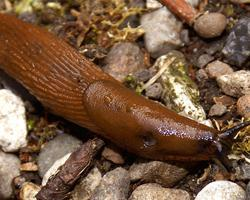
Poids et mesures
| Longueur | de 8 à 12 cm |
|---|---|
| Poids | de 3 à 27 g |
Statut de conservation
| Intrépide |
Description de l'animal
The Spanish slug, scientifically known as Arion vulgaris, is a terrestrial gastropod mollusk that belongs to the family Arionidae. This species, often considered a pest due to its voracious appetite for plants, is native to the Iberian Peninsula but has spread to many other parts of Europe and beyond, causing significant agricultural and garden damage.Arion vulgaris is characterized by its relatively large size, with adults typically reaching lengths of up to 15 centimeters, although sizes can vary. The body of the Spanish slug is soft and moist, with a skin texture that feels slightly sticky to the touch. The coloration of these slugs can vary significantly, ranging from yellow and orange to brown and almost black, often with darker spots or a mottled pattern. This variability in coloration can sometimes make it difficult to distinguish Arion vulgaris from other slug species.
One of the most distinctive features of the Spanish slug is its respiratory pore, located on the right side of its mantle. This pore is an opening to the slug's lung, allowing it to breathe air. Surrounding the respiratory pore, the mantle is usually a lighter color than the rest of the body, which can help in identifying the species.
The Spanish slug is a hermaphrodite, meaning each individual possesses both male and female reproductive organs. After mating, which can involve complex behaviors including the exchange of sperm packets, the slugs lay clusters of translucent, gelatinous eggs in moist, protected locations. These eggs are resistant to both drying out and freezing, contributing to the species' resilience and rapid spread.
Arion vulgaris is particularly notorious for its dietary habits. It has a broad diet and is known to consume a wide variety of plants, including many that are economically important to humans. This includes vegetables, flowers, and even some trees and shrubs. The slug's feeding activity can cause significant damage to gardens, agricultural fields, and natural ecosystems. Unlike some other slug species, the Spanish slug is also known to scavenge dead animal matter and consume pet food, demonstrating its opportunistic feeding behavior.
The rapid spread of the Spanish slug beyond its native range has been facilitated by human activity, particularly through the movement of plants and soil. Once established in a new area, its high reproductive rate and lack of natural predators can lead to population explosions. Control measures often involve a combination of methods, including physical barriers, chemical molluscicides, and biological control agents. However, these methods can have varying degrees of success and may also impact non-target species and the environment.
Environmental conditions play a significant role in the activity patterns of Arion vulgaris. They are primarily nocturnal, coming out to feed at night when the risk of desiccation is lower. During the day, they hide in moist, shaded locations to conserve moisture. Temperature and humidity levels can significantly affect their activity; they are less active during hot, dry periods and more active during cool, moist conditions.
In conclusion, the Spanish slug, Arion vulgaris, is a fascinating yet problematic species. Its adaptability, broad diet, and reproductive capabilities have enabled it to become a successful invasive species in many parts of the world. While it poses significant challenges to agriculture, horticulture, and natural ecosystems, understanding its biology and behavior is crucial for developing effective management strategies to mitigate its impact.
Animaux similaires
Nouvelles photos d'animaux
Top 10 des animaux
- Dolphin gull (Leucophaeus scoresbii)
- Diana monkey (Cercopithecus diana)
- Moustached guenon (Cercopithecus cephus)
- Galápagos tortoise (Geochelone nigra complex)
- Japanese macaque (Macaca fuscata)
- Stone loach (Barbatula barbatula)
- Russian tortoise (Testudo horsfieldii)
- Greek tortoise (Testudo graeca)
- Common flying dragon (Draco volans)
- Vendace (Coregonus albula)
